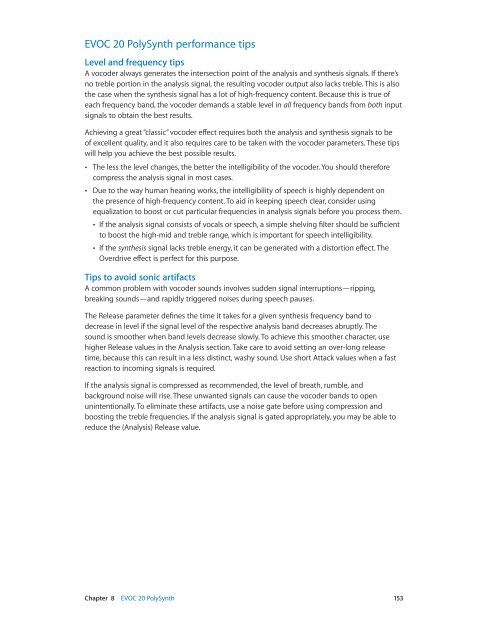Apple MainStage 3 Instruments - MainStage 3 Instruments
Apple MainStage 3 Instruments - MainStage 3 Instruments
Apple MainStage 3 Instruments - MainStage 3 Instruments
Create successful ePaper yourself
Turn your PDF publications into a flip-book with our unique Google optimized e-Paper software.
EVOC 20 PolySynth performance tips<br />
Level and frequency tips<br />
A vocoder always generates the intersection point of the analysis and synthesis signals. If there’s<br />
no treble portion in the analysis signal, the resulting vocoder output also lacks treble. This is also<br />
the case when the synthesis signal has a lot of high-frequency content. Because this is true of<br />
each frequency band, the vocoder demands a stable level in all frequency bands from both input<br />
signals to obtain the best results.<br />
Achieving a great “classic” vocoder effect requires both the analysis and synthesis signals to be<br />
of excellent quality, and it also requires care to be taken with the vocoder parameters. These tips<br />
will help you achieve the best possible results.<br />
••<br />
The less the level changes, the better the intelligibility of the vocoder. You should therefore<br />
compress the analysis signal in most cases.<br />
••<br />
Due to the way human hearing works, the intelligibility of speech is highly dependent on<br />
the presence of high-frequency content. To aid in keeping speech clear, consider using<br />
equalization to boost or cut particular frequencies in analysis signals before you process them.<br />
••<br />
If the analysis signal consists of vocals or speech, a simple shelving filter should be sufficient<br />
to boost the high-mid and treble range, which is important for speech intelligibility.<br />
••<br />
If the synthesis signal lacks treble energy, it can be generated with a distortion effect. The<br />
Overdrive effect is perfect for this purpose.<br />
Tips to avoid sonic artifacts<br />
A common problem with vocoder sounds involves sudden signal interruptions—ripping,<br />
breaking sounds—and rapidly triggered noises during speech pauses.<br />
The Release parameter defines the time it takes for a given synthesis frequency band to<br />
decrease in level if the signal level of the respective analysis band decreases abruptly. The<br />
sound is smoother when band levels decrease slowly. To achieve this smoother character, use<br />
higher Release values in the Analysis section. Take care to avoid setting an over-long release<br />
time, because this can result in a less distinct, washy sound. Use short Attack values when a fast<br />
reaction to incoming signals is required.<br />
If the analysis signal is compressed as recommended, the level of breath, rumble, and<br />
background noise will rise. These unwanted signals can cause the vocoder bands to open<br />
unintentionally. To eliminate these artifacts, use a noise gate before using compression and<br />
boosting the treble frequencies. If the analysis signal is gated appropriately, you may be able to<br />
reduce the (Analysis) Release value.<br />
Chapter 8 EVOC 20 PolySynth 153
















